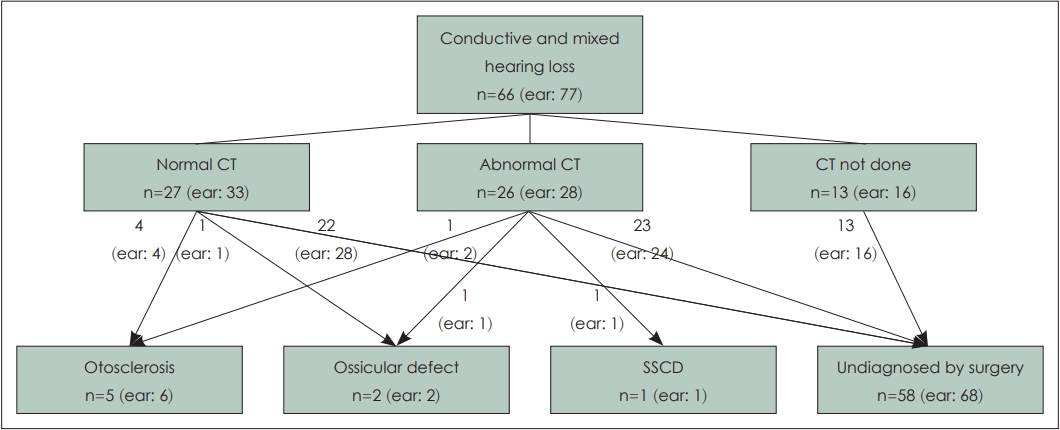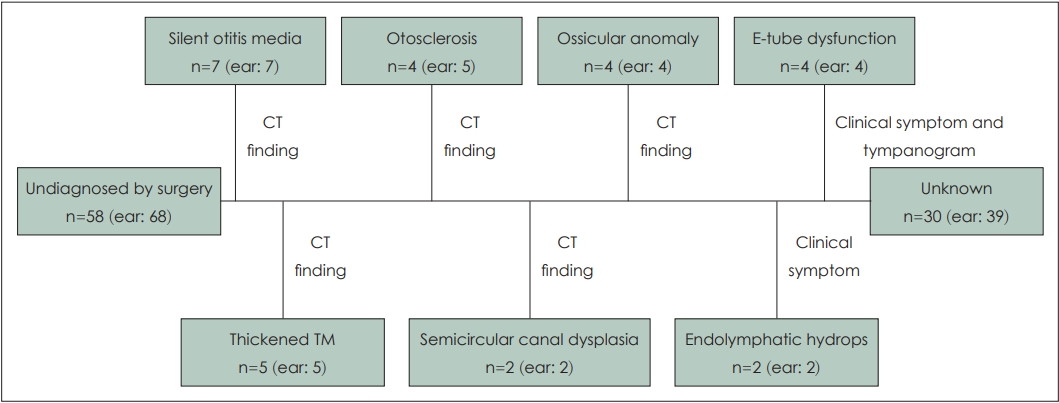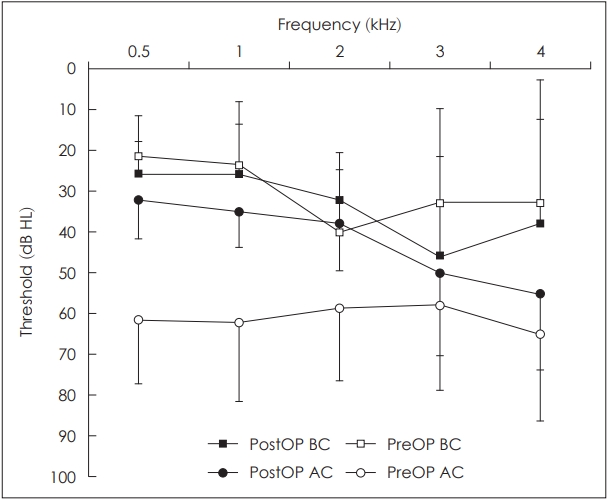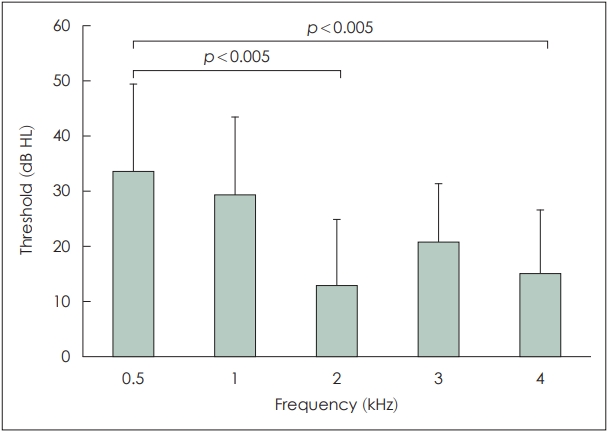 |
 |
AbstractBackground and ObjectivesThis study aimed to investigate the causes, clinical manifestations, temporal bone CT findings, and audiologic results of outpatients with non-traumatic hearing loss with air-bone gaps and intact tympanic membranes.
Subjects and MethodThe medical records from 2014 to 2022 of 66 patients (77 ears) with normal tympanic membranes but who had the air-bone gap of more than 20 dB over two consecutive frequencies were reviewed.
ResultsThe mean age of the patients was 46.8┬▒17.0 years old. The mean air-bone gap was 24.8┬▒10.3 dB. Of the 77 ears (66 patients) studied, 10 ears were surgically diagnosed with otosclerosis (6 ears), ossicular discontinuity (2 ears), superior semicircular canal dehiscence (1 ear), and unknown etiology (1 ear). Additionally, 29 more ears (28 patients) were clinically diagnosed with silent otitis media (7 ears), otosclerosis (5 ears), thickened tympanic membrane (5 eras), E-tube dysfunction (4 ears), ossicular anomaly (4 ears), semicircular canal dysplasia (2 ears), and endolymphatic hydrops (2 ears). Temporal bone CT images showed normal findings in 33 ears (54.1%) and abnormal findings in 28 ears (45.9%). Patients with abnormal CT findings had a poorer speech discrimination score than those with normal findings (p<0.05). The airbone gap was significantly decreased postoperatively from 30.5┬▒12.7 dB to 6.4┬▒4.0 dB, with a tendency to decrease greater at a low frequency than at a high frequency.
ņä£ ļĪĀņĀäņØīņä▒ ļé£ņ▓ŁņØĆ ņÖĖņØ┤, Ļ│Āļ¦ē, ņżæņØ┤Ļ░ĢņØś ļ¼ĖņĀ£ļĪ£ ĻĖ░ļÅäļź╝ ĒåĄĒĢ£ ņåīļ”¼ņØś ņĀäļŗ¼ņØ┤ ņĀĢņāüņĀüņ£╝ļĪ£ ņØ┤ļŻ©ņ¢┤ņ¦Ćņ¦Ć ņĢŖņĢä ļ░£ņāØĒĢśļŖö ļé£ņ▓Łņ£╝ļĪ£ ņł£ņØīņ▓ŁļĀźĻ▓Ćņé¼ņŚÉņä£ ĻĖ░ļÅäĻ│©ļÅäņ░©ļź╝ ņ£Āļ░£ĒĢśĻ▓ī ļÉśĻ│Ā ĻĘĖ ņĀĢļÅäļŖö ņøÉņØĖņØś ņ£äņ╣śņŚÉ ļö░ļØ╝ ļŗżļźĖļŹ░ 20-25 dB ņØ┤ņāüņØś ĻĖ░ļÅäĻ│©ļÅäņ░©ļŖö ņżæņØ┤ņØś ļ¼ĖņĀ£ļź╝ ņÜ░ņäĀņĀüņ£╝ļĪ£ Ļ│ĀļĀżĒĢ┤ņĢ╝ ĒĢśļ®░, ņł£ņłśĒĢ£ ņĀäņØīņä▒ ļé£ņ▓ŁņŚÉņä£ ĻĖ░ļÅäņ▓ŁļĀźņØĆ 60 dBņØä ņ┤łĻ│╝ĒĢśņ¦Ć ņĢŖļŖöļŗż[1-3]. Ēś╝ĒĢ®ņä▒ ļé£ņ▓ŁņØĆ ĻĖ░ļÅäņ▓ŁļĀźĻ│╝ Ļ│©ļÅäņ▓ŁļĀź ņŚŁņ╣śĻ░Ć ļ¬©ļæÉ ņ”ØĻ░ĆļÉśņ¢┤ ņ׳ņ£╝ļ®┤ņä£ ĻĖ░ļÅä ņ▓ŁļĀźņØ┤ 10 dB ņØ┤ņāü ļŹö ņ”ØĻ░ĆļÉ£ Ļ▓ĮņÜ░ļź╝ ņØśļ»ĖĒĢ£ļŗż[4]. ņÜ░ļ”¼ļéśļØ╝ ĻĄŁļ»╝Ļ▒┤Ļ░Ģņśüņ¢æņĪ░ņé¼(2010-2012) Ļ▓░Ļ│╝ņŚÉ ļö░ļź┤ļ®┤ 12ņäĖ ņØ┤ņāüņŚÉņä£ ņ£ĀĒśĢņŚÉ Ļ┤ĆĻ│äņŚåņØ┤ 25 dB ņØ┤ņāüņØś ļé£ņ▓ŁņØä Ļ░Ćņ¦ĆļŖö ļ╣äņ£©ņØĆ 22.73%ļĪ£ ņĪ░ņé¼ļÉśņŚłļŗż[5]. ņŗ¼ņé¼ĒÅēĻ░ĆņøÉ ņ×ÉļŻīņŚÉ ļö░ļź┤ļ®┤ 2021ļģäļÅäņŚÉ ļé£ņ▓Łņ£╝ļĪ£ ņ¦äļŻīļ░øņØĆ ĒÖśņ×É ņłśļŖö 212757ļ¬ģņØĖļŹ░ ĻĘĖņżæ ņĀäņØīņä▒ ļé£ņ▓ŁĻ│╝ Ēś╝ĒĢ®ņä▒ ļé£ņ▓ŁņØĆ Ļ░üĻ░ü 24945ļ¬ģ(11.7%)ņÖĆ 52631ļ¬ģ(24.7%)ņØĖ Ļ▓āņ£╝ļĪ£ ņĪ░ņé¼ļÉśņŚłļŗż[6]. ĒĢ┤ņÖĖņØś ļ¼ĖĒŚīņŚÉņä£ļŖö 18ņäĖ ņØ┤ņāüņŚÉņä£ 25 dB ņØ┤ņāüņØś ļé£ņ▓Ł ĒÖśņ×ÉņØś ļ╣äņ£©ņØĆ 16%-20%ņØ┤Ļ│Ā[7-9], ņØ┤ ņżæ ņĀäņØīņä▒ ļé£ņ▓ŁņØś ļ╣äņżæņØĆ 3%-10%ļź╝ ņ░©ņ¦ĆĒĢśļŖö Ļ▓āņ£╝ļĪ£ ņĢīļĀżņĀĖ ņ׳ļŗż[8,9].
ĻĖ░ļÅäĻ│©ļÅäņ░©ļź╝ ņ£Āļ░£ĒĢśļŖö ņøÉņØĖņ£╝ļĪ£ļŖö ņÖĖņØ┤ļÅäņŚ╝, ņÖĖņØ┤ļÅä ĒÅÉņāē ļō▒ ņÖĖņØ┤ļÅäņØś ļ¼ĖņĀ£ņÖĆ Ļ│Āļ¦ēņ▓£Ļ│Ą, ņé╝ņČ£ņä▒ ņżæņØ┤ņŚ╝, ļ¦īņä▒ ņżæņØ┤ņŚ╝, ņ¦äņŻ╝ņóģ ļō▒ ņżæņØ┤ņØś Ļ░ÉņŚ╝ņØ┤ļéś ņŚ╝ņ”ØņŚÉ ņØśĒĢ£ Ļ▓ĮņÜ░Ļ░Ć ĒØöĒĢśĻ│Ā ļō£ļ¼╝Ļ▓ī ļé┤ņØ┤ ņ¦łĒÖśņŚÉ ĻĖ░ņØĖĒĢśļŖö Ļ▓ĮņÜ░ļÅä ņ׳ļŗż[2,10]. ņŚ╝ņ”ØņŚÉ ņØśĒĢ£ ņżæņØ┤ ņ¦łĒÖśņØś Ļ▓ĮņÜ░ ļīĆļČĆļČä ņØ┤ļé┤ņŗ£Ļ▓Į ļō▒ņ£╝ļĪ£ Ļ│Āļ¦ēņØś ņØ┤ņāü ļśÉļŖö Ļ│Āļ¦ē ļé┤ļČĆņØś ļ│æļ│ĆņØä Ļ┤Ćņ░░ĒĢĀ ņłś ņ׳ņ£╝ļéś[2], ļō£ļ¼╝Ļ▓ī ņĀĢņāü Ļ│Āļ¦ēņ×äņŚÉļÅä ņł£ņØīņ▓ŁļĀźĻ▓Ćņé¼ņŚÉņä£ ĻĖ░ļÅäĻ│©ļÅäņ░©ļź╝ ļ│┤ņØ┤ļŖö ņ▓ŁļĀźļÅäļź╝ ļéśĒāĆļé┤ļŖö Ļ▓ĮņÜ░Ļ░Ć ņ׳ļŗż. ņØ┤ļ¤¼ĒĢ£ Ļ▓ĮņÜ░ ļæÉļČĆņÖĖņāüņØś ļ│æļĀźĻ│╝ ņ¢┤ņ¦Ćļ¤╝ņ”ØņØ┤ļéś ņ▓ŁĻ░üĻ│╝ļ»╝ ļō▒ ļÅÖļ░ś ņ”ØņāüņØä ĒÖĢņØĖĒĢ┤ņĢ╝ ĒĢ£ļŗż. ļśÉĒĢ£ ņØīņ░© Ļ▓Ćņé¼ ļō▒ņ£╝ļĪ£ ņł£ņØīņ▓ŁļĀźĻ▓Ćņé¼ Ļ▓░Ļ│╝ļź╝ Ļ▓Ćņ”ØĒĢśĻ│Ā ņ×äĒö╝ļŹśņŖż ņ▓ŁļĀźĻ▓Ćņé¼ņÖĆ ĒåĄĻĖ░ ņØ┤Ļ▓Į(pneumatic otoscope) ļō▒ņØä ņØ┤ņÜ®ĒĢśņŚ¼ ņżæņØ┤Ļ░Ģ ļé┤ļČĆņŚÉ ņל ļ│┤ņØ┤ņ¦Ć ņĢŖļŖö ļ│æļ│ĆņØä ņ░ŠņĢäļ│┤ņĢäņĢ╝ ĒĢ£ļŗż[1]. ņĀĢņāü Ļ│Āļ¦ēĻ│╝ ĻĖ░ļÅä Ļ│©ļÅäņ░©ļź╝ Ļ░Ćņ¦ĆļŖö ļé£ņ▓ŁņŚÉņä£ ņĖĪļæÉĻ│© CTļź╝ ĒåĄĒĢ┤ ņØ┤ņåīĻ│©ņØä ĒżĒĢ©ĒĢ£ ņżæņØ┤Ļ░Ģ, ņ£Āņ¢æļÅīĻĖ░, ļé┤ņØ┤ ļ░Å ņĀäņĀĢņłśļÅäĻ┤ĆņØś ņāüĒā£ļź╝ ĒÖĢņØĖĒĢśļŖö Ļ▓āņØĆ ĒĢäņłśņĀüņØĖ ņ¦äļŗ© Ļ│╝ņĀĢņØĖļŹ░ ņĖĪļæÉĻ│© CTņŚÉņä£ļÅä ļ│æļ│ĆņØä Ļ┤Ćņ░░ĒĢĀ ņłś ņŚåļŖö Ļ▓ĮņÜ░ņŚÉļŖö ņŗ£ĒŚśņĀü Ļ│ĀņŗżĻ░£ļ░®ņłĀļĪ£ ĻĘĖ ņøÉņØĖņØä ņ░ŠņĢäļ│┤ļŖö ļ░®ļ▓ĢņØ┤ ņ£ĀņØ╝ĒĢ£ ļ░®ļ▓ĢņØ┤Ļ│Ā 20 dB ņØ┤ņāüņØś ņĀäņØīņä▒ ļé£ņ▓ŁņØ┤ ņ¦ĆņåŹļÉĀ ļĢī ņŗ£ĒŚśņĀü Ļ│Āņŗż Ļ░£ļ░®ņłĀņØś ņĀüņØæņ”ØņØ┤ ļÉ£ļŗż[11]. ņŗ£ĒŚśņĀü Ļ│Āņŗż Ļ░£ļ░®ņłĀņØś Ļ▓ĮņÜ░ ĻĖ░ļÅäĻ│©ļÅäņ░©ņØś ņĀĢļÅä, ĒÖśņ×ÉņØś ļéśņØ┤, ļ░śļīĆņĖĪ ņ▓ŁļĀź ņāüĒā£, ĒÖśņ×ÉņØś ņäĀĒśĖļÅä ļō▒ņØä ļ¬©ļæÉ Ļ│ĀļĀżĒĢśņŚ¼ Ļ▓░ņĀĢĒĢśĻ▓ī ļÉśļŖöļŹ░ ņłśņłĀņØä ņŗ£Ē¢ēĒĢśņ¦Ć ņĢŖļŖö Ļ▓ĮņÜ░ ĻĘĖ ņøÉņØĖņØĆ ļ»Ėņāüņ£╝ļĪ£ ļé©Ļ▓ī ļÉśļŖö Ļ▓ĮņÜ░Ļ░Ć ļ¦Äļŗż.
ņĀĢņāü Ļ│Āļ¦ēĻ│╝ ĻĖ░ļÅäĻ│©ļÅäņ░©ļź╝ Ļ░Ćņ¦ĆļŖö ļé£ņ▓ŁņØä ļīĆņāüņ£╝ļĪ£ ĒĢ£ ĻĖ░ņĪ┤ ņŚ░ĻĄ¼ļōżņØĆ ņłśņłĀ Ļ▓░Ļ│╝ņŚÉ ļīĆĒĢ£ ļČäņäØņØ┤ļéś ņØ┤Ļ▓ĮĒÖöņ”Ø ļō▒ ĒŖ╣ņĀĢ ņ¦łĒÖśņØ┤ ĻĄŁĒĢ£ļÉ£ ļČäņäØņØ┤ ņŻ╝ļź╝ ņØ┤ļŻ©Ļ│Ā ņ׳ļŗż[10,12-14]. ĻĘĖļ¤¼ļéś ņŗżņĀ£ ņ×äņāüĒÖśĻ▓ĮņŚÉņä£ļŖö ņŚ¼ļ¤¼ Ļ░Ćņ¦Ć ņØ┤ņ£ĀļĪ£ ņłśņłĀņØä ļ░øņ¦Ć ņĢŖļŖö Ļ▓ĮņÜ░Ļ░Ć ļ¦ÄĻĖ░ ļĢīļ¼ĖņŚÉ ņłśņłĀņØä ļ░øņ¦Ć ņĢŖņØĆ ĒÖśņ×ÉļōżļÅä ĒżĒĢ©ĒĢśņŚ¼ ĻĘĖļōżņØś ņ×äņāüņ¢æņāüņØä ļČäņäØĒĢ£ Ļ▓░Ļ│╝ļŖö ņŗżņĀ£ ĒÖśņ×É ņ¦äļŻīņŚÉ ņ£ĀņÜ®ĒĢ£ ņĀĢļ│┤ļź╝ ņĀ£Ļ│ĄĒĢĀ ņłś ņ׳ņØä Ļ▓āņ£╝ļĪ£ ņāØĻ░üļÉ£ļŗż. ļ│Ė ņŚ░ĻĄ¼ņŚÉņä£ļŖö ļ│æļĀź ņ▓ŁņĘ© ļō▒ņ£╝ļĪ£ ĻĘĖ ņøÉņØĖņØä ļ╣äĻĄÉņĀü ņēĮĻ▓ī ņ░ŠņØä ņłś ņ׳ļŖö ņÖĖņāüņä▒ ņØ┤ņåīĻ│© ņåÉņāüņØĆ ņĀ£ņÖĖĒĢśĻ│Ā ņŗ£ĒŚśņĀü Ļ│ĀņŗżĻ░£ļ░®ņłĀņØä ĒĢśņ¦Ć ņĢŖĻ│ĀļŖö ĻĘĖ ņøÉņØĖņØä ņĀĢĒÖĢĒ׳ ļŗ©ņĀĢĒĢśĻĖ░ ņ¢┤ļĀżņÜ┤ Ļ▓ĮņÜ░ļ¦īņØä ļīĆņāüņ£╝ļĪ£ ĒĢśņśĆļŗż. ļ│Ė ņŚ░ĻĄ¼ņØś ļ¬®ņĀüņØĆ ņĀĢņāü Ļ│Āļ¦ēĻ│╝ ĻĖ░ļÅäĻ│©ļÅäņ░©ļź╝ Ļ░Ćņ¦ĆļŖö ļ¬©ļōĀ ĒÖśņ×ÉļōżņØä ļ╣äņÖĖņāüņä▒ ļé£ņ▓ŁņØś ņ×äņāüņ¢æņāü, ņĖĪļæÉĻ│© CT ņåīĻ▓¼, ņ▓ŁļĀźĻ▓Ćņé¼ Ļ▓░Ļ│╝, ņøÉņØĖ ņ¦łĒÖś ļō▒ņØä ļČäņäØĒĢśļŖö Ļ▓āņØ┤ļŗż.
ļīĆņāü ļ░Å ļ░®ļ▓ĢņŚ░ĻĄ¼ ļīĆņāü2014ļģä 1ņøöļČĆĒä░ 2022ļģä 11ņøöĻ╣īņ¦Ć ļģĖņøÉņØäņ¦ĆļīĆĒĢÖĻĄÉļ│æņøÉ ņØ┤ļ╣äņØĖĒøäĻ│╝ ņÖĖļלļĪ£ ļé┤ņøÉĒĢśņŚ¼ ņŗ£Ē¢ēĒĢ£ ņł£ņØīņ▓ŁļĀźĻ▓Ćņé¼ņŚÉņä£ ņĀäņØīņä▒ ļé£ņ▓Ł ļśÉļŖö Ēś╝ĒĢ®ņä▒ ļé£ņ▓Ł ņ¦äļŗ©ņØä ļ░øņØĆ 66ļ¬ģ ņä▒ņØĖ ĒÖśņ×ÉļōżņØś ņØśļ¼┤ĻĖ░ļĪØĻ│╝ ņĖĪļæÉĻ│© CTļź╝ ļČäņäØĒĢśņśĆļŗż. ļČäņäØ ļīĆņāüņØĆ 18ņäĖ ņØ┤ņāüņØś ņä▒ņØĖņ£╝ļĪ£ņä£ ņ¢æņĖĪ Ļ│Āļ¦ē ņåīĻ▓¼ņØ┤ ņØ┤ļé┤ņŗ£Ļ▓ĮĻ▓Ćņé¼ņŚÉņä£ ņĀĢņāüņØ┤Ļ│Ā, ņł£ņØīņ▓ŁļĀźĻ▓Ćņé¼ņØś ņŚ░ņåŹļÉ£ ļæÉ ņŻ╝Ēīīņłś ņØ┤ņāüņŚÉņä£ ĻĖ░ļÅäĻ│©ļÅäņ░©Ļ░Ć 20 dB ņØ┤ņāüņØĖ Ļ▓ĮņÜ░ļź╝ ĒżĒĢ©ņŗ£ņ╝░ļŗż. ņÖĖņØ┤ ĻĖ░ĒśĢņØ┤ ņ׳ļŖö Ļ▓ĮņÜ░, Ļ│Āļ¦ē ļé┤ ņé╝ņČ£ņĢĪņØ┤ ņ׳ļŖö Ļ▓ĮņÜ░, ļæÉĻ▓ĮļČĆ ņÖĖņāüņØ┤ļéś ņłśņłĀļĀźņØ┤ ņ׳ļŖö Ļ▓ĮņÜ░ļŖö ņĀ£ņÖĖĒĢśņśĆļŗż. 66ļ¬ģ ĒÖśņ×ÉņØś 77ĻĘĆĻ░Ć ĒżĒĢ©ĻĖ░ņżĆņØä ļ¦īņĪ▒ĒĢśņŚ¼ ļČäņäØļīĆņāüņØ┤ ļÉśņŚłĻ│Ā ņĄ£ņóģ ņ¦äļŗ©ņØĆ ņłśņłĀņØä ĒåĄĒĢ┤ ĒÖĢņØĖļÉ£ ļ░öļ¦ī ĻĖ░ņ×¼ĒĢśņśĆĻ│Ā ņłśņłĀņØä ļ░øņ¦Ć ņĢŖņØĆ Ļ▓ĮņÜ░ ļ»Ėņāüņ£╝ļĪ£ ĻĖ░ņ×¼ĒĢśņśĆļŗż. ļ│Ė ņŚ░ĻĄ¼ļŖö ņĀĆņ×ÉĻ░Ć ņåīņåŹļÉ£ ĻĖ░Ļ┤ĆņØś ņŚ░ĻĄ¼ņ£żļ”¼ņŗ¼ņØśņ£äņøÉĒÜīņØś ņŖ╣ņØĖņØä ļ░øņĢśļŗż(ņŖ╣ņØĖļ▓łĒśĖ: EMCS 2023-01-021).
Ļ▓Ć ņé¼ņĖĪļæÉĻ│© CTļŖö GE HealthCare (Chicago, IL, USA)ņØś SOMATOMņ£╝ļĪ£ 120 kV (ņĄ£ļīĆ), 86 mA, 0.6 mm ņŖ¼ļØ╝ņØ┤ņŖż ļæÉĻ╗śļĪ£ ņ┤¼ņśüĒĢśņśĆĻ│Ā ņśüņāüņØśĒĢÖĻ│╝ņØś ņĀĢņŗØ ĒīÉļÅģņØä ĻĘ╝Ļ▒░ļĪ£ CT ņåīĻ▓¼ņØä ļČäņäØĒĢśņśĆļŗż. ņł£ņØīņ▓ŁļĀźĻ▓Ćņé¼ļŖö ĻĖ░ļÅäņÖĆ Ļ│©ļÅäņŚÉ ļīĆĒĢ┤ ņŗ£Ē¢ēĒĢśņśĆņ£╝ļ®░, 250, 500, 1000, 2000, 3000, 4000 Hzļź╝ ĻĖ░ļĪØĒĢśņśĆļŗż. ĻĖ░ļÅäĻ│©ļÅäņ░©ļŖö ļ»ĖĻĄŁ ņØ┤ļ╣äņØĖĒøäĻ│╝-ļæÉĻ▓ĮļČĆņÖĖĻ│╝ĒĢÖĒÜī(American Academy of Otolaryngology-Head and Neck Surgery)ņØś Ļ░ĆņØ┤ļō£ļØ╝ņØĖņŚÉ ļö░ļØ╝ 500, 1000, 2000, 3000 HzņŚÉņä£ ĻĖ░ļÅä ņ▓ŁļĀźĻ│╝ Ļ│©ļÅä ņ▓ŁļĀźņØś ĒÅēĻĘĀ ņ░©ņØ┤ļĪ£ Ļ│äņé░ĒĢśņśĆļŗż[15]. ļśÉĒĢ£, ņĄ£ņĀüņĢłņĀĢņŚŁņ╣śņŚÉņä£ ņĖĪņĀĢĒĢ£ ņ¢┤ņØīļ¬ģļŻīļÅäļź╝ ļČäņäØņŚÉ ĒżĒĢ©ņŗ£ņ╝░ļŗż. ĻĖ░ļÅäĻ│©ļÅä ņ░© ņśüņŚŁņØä ņŻ╝Ēīīņłśļ│äļĪ£ ļČäļźśĒĢśņśĆļŖöļŹ░, ņĀĆņØīņŚŁļīĆļŖö 250, 500, 1000 kHz ņżæ ņŚ░ņåŹļÉ£ ļæÉ ņŻ╝ĒīīņłśņŚÉņä£ ĻĖ░ļÅäĻ│©ļÅäņ░©Ļ░Ć 20 dB ņØ┤ņāüņØ╝ ļĢī, Ļ│ĀņØīņŚŁļīĆļŖö 2000, 3000, 4000 Hz ņżæ ņŚ░ņåŹļÉ£ ļæÉ ņŻ╝ĒīīņłśņŚÉņä£ ĻĖ░ļÅäĻ│©ļÅäņ░©Ļ░Ć 20 dB ņØ┤ņāüņØ╝ ļĢīļĪ£ ņĀĢņØśĒĢśņśĆļŗż[16]. Ļ│ĀņŗżļÅä Ļ▓Ćņé¼ļŖö -100~+100 mmH2OņŚÉņä£ ņĄ£ļīĆ Ēāäņä▒ņØ┤ Ļ┤Ćņ░░ļÉśļŖö Ļ▓āņØä AĒśĢ, ņĄ£ļīĆ Ēāäņä▒ņØ┤ AņÖĆ Ļ░ÖņØĆ ļ▓öņ£äņŚÉ ņ׳ņ£╝ļéś Ēāäņä▒ņØś ļ│ĆĒÖöĻ░Ć 0.3 mL ļ»Ėļ¦īņØĖ Ļ▓ĮņÜ░ As, ņĄ£ļīĆ Ēāäņä▒ņØ┤ AņÖĆ Ļ░ÖņØĆ ļ▓öņ£äņŚÉ ņ׳ņ£╝ļéś Ēāäņä▒ņØś ļ│ĆĒÖöĻ░Ć 1.5 mL ņ┤łĻ│╝ņØĖ Ļ▓ĮņÜ░ Ad, ņĄ£ļīĆ Ēāäņä▒ņØ┤ -100 mmH2O ļ»Ėļ¦īņŚÉņä£ Ļ┤Ćņ░░ļÉśļŖö Ļ▓āņØä CĒśĢņ£╝ļĪ£ ņĀĢņØśĒĢśņśĆļŗż.
ĒåĄĻ│ä ļČäņäØĒåĄĻ│ä ļČäņäØņØĆ SPSS ļ▓äņĀä 18.0 (SPSS I nc., C hicago, IL, USA)ņØä ņØ┤ņÜ®ĒĢśņŚ¼ ļČäņäØĒĢśņśĆļŗż. ņØĖĻĄ¼ĒĢÖņĀü ĒŖ╣ņä▒ Ļ░ä ļ╣łļÅä ņ░©ņØ┤ļź╝ ļČäņäØĒĢśĻĖ░ ņ£äĒĢ┤ Žć2-testņÖĆ ļĪ£ņ¦ĆņŖżĒŗ▒ ĒÜīĻĘĆļČäņäØņØä ņØ┤ņÜ®ĒĢśņśĆĻ│Ā, ņĖĪļæÉĻ│© CT ņåīĻ▓¼ņŚÉ ļö░ļźĖ ņ▓ŁļĀźļÅä ļ╣äĻĄÉļź╝ ņ£äĒĢ┤ independent t-testļź╝ ņØ┤ņÜ®ĒĢśņśĆĻ│Ā, ņłśņłĀ ņĀäĒøä ņ▓ŁļĀźņŚŁņ╣śņØś ļ╣äĻĄÉņÖĆ ņłśņłĀ Ēøä ĻĖ░ļÅäĻ│©ļÅäņ░©ņØś ļ│ĆĒÖöļź╝ ņŻ╝Ēīīņłśļ│äļĪ£ ļ╣äĻĄÉĒĢśĻĖ░ ņ£äĒĢ┤ paired t-testļź╝ ņØ┤ņÜ®Ē¢łļŗż. ņŻ╝Ēīīņłśļ│ä ļ╣äĻĄÉļŖö Bonferroni ĻĄÉņĀĢņØä ņĀüņÜ®ĒĢ£ p’╝£0.005ļź╝ ņ£ĀņØśņłśņżĆņ£╝ļĪ£ ĒĢśņśĆĻ│Ā ļéśļ©Ėņ¦Ć ĒåĄĻ│äļŖö p’╝£0.05ļź╝ ņ£ĀņØśņłśņżĆņ£╝ļĪ£ ĒĢśņśĆļŗż.
Ļ▓░ Ļ│╝ņØĖĻĄ¼ĒĢÖņĀü ĒŖ╣ņä▒66ļ¬ģ ĒÖśņ×ÉļōżņØś ļéśņØ┤ļŖö 18ņäĖņŚÉņä£ 72ņäĖĻ╣īņ¦Ć ļČäĒżĒĢśņśĆĻ│Ā, ĒÅēĻĘĀņØĆ 46.8┬▒17.0ņäĖņśĆļŗż(Table 1). ņØ┤ ņżæ 38ļ¬ģ(57.6%)ņØ┤ ņŚ¼ņ×ÉņśĆĻ│Ā, 28ļ¬ģ(42.4%)ņØ┤ ņÜ░ņĖĪ ĻĘĆņśĆļŗż. ņ¢æņĖĪļ│┤ļŗżļŖö ņØ╝ņĖĪ ņ▓ŁļĀźņĀĆĒĢśņØś ļ╣łļÅäĻ░Ć ļåÆņĢśĻ│Ā(Žć2 [2, 66]=8.27, p=0.02), ņóīņÜ░ Ļ░äņŚÉ ņ░©ņØ┤ļŖö ņŚåņŚłļŗż(p’╝×0.05). ĻĖ░ļÅäĻ│©ļÅäņ░©ļŖö ĒÅēĻĘĀ 24.8┬▒10.3 dBļĪ£ 10-19 dBņŚÉ 24ļ¬ģ(36.4%), 20-29 dBņŚÉ 22ļ¬ģ(33.3%), 30-39 dBņØĆ 11ļ¬ģ(16.7%), 40 dB ņØ┤ņāüņØĆ 9ļ¬ģ(13.6%) ļČäĒżĒĢśņśĆļŗż. ĻĖ░ļÅäĻ│©ļÅäņ░©ļź╝ ļ│┤ņØ┤Ļ│Ā ņŚ░ņåŹļÉ£ ļæÉ ņŻ╝ĒīīņłśņŚÉņä£ Ļ│©ļÅäņ▓ŁļĀźņØ┤ 25 dBņØä ņ┤łĻ│╝ĒĢśļŖö Ļ▓ĮņÜ░ Ēś╝ĒĢ®ņä▒ ļé£ņ▓Łņ£╝ļĪ£ ņĀĢņØśĒĢśņśĆĻ│Ā, ņĀäņØīņä▒ ļé£ņ▓ŁĻ│╝ Ēś╝ĒĢ®ņä▒ ļé£ņ▓ŁņØś ļ╣äņ£©ņØĆ Ļ░üĻ░ü 28ļ¬ģ(42.4%), 38ļ¬ģ(57.6%)ļĪ£ ņ£ĀņØśļ»ĖĒĢ£ ņ░©ņØ┤Ļ░Ć ņŚåņŚłĻ│Ā(p’╝×0.05), ņŚ░ļĀ╣ņØ┤ ņ”ØĻ░ĆĒĢĀņłśļĪØ Ēś╝ĒĢ®ņä▒ ļé£ņ▓ŁņØä ļ│┤ņØ╝ ĒÖĢļźĀņØ┤ ņ”ØĻ░ĆĒĢśļŖö Ļ▓āņ£╝ļĪ£ ļéśĒāĆļé¼ļŗż(OR=1.07, 95% CI 1.028-1.106, p’╝£0.05). ĻĖ░ļÅäĻ│©ļÅäņ░©ļź╝ ņŻ╝Ēīīņłśļ│äļĪ£ ļéśļłäņŚłņØä ļĢī, ņĀĆņØīņŚŁļīĆļŖö 29ļ¬ģ(43.9%), ņĀäņØīņŚŁļīĆļŖö 37ļ¬ģ(56.1%), Ļ│ĀņØīņŚŁļīĆļŖö 0ĻĘĆņśĆļŗż(Table 1).
ņłśņłĀņØä ĒåĄĒĢ£ ņ¦äļŗ©Ļ│╝ ņĖĪļæÉĻ│© CT Ļ▓░Ļ│╝66ļ¬ģņØś ĒÖśņ×ÉņØś 77ĻĘĆ ņżæ ņłśņłĀļĪ£ ņ¦äļŗ©ļ¬ģņØ┤ ĒÖĢņØĖļÉ£ Ļ▓ĮņÜ░Ļ░Ć 10ĻĘĆ ņ׳ņŚłĻ│Ā, ņØ┤Ļ▓ĮĒÖöņ”Ø 6ĻĘĆ, ņØ┤ņåīĻ│©ņŚ░ņćä ļŗ©ņĀł 2ĻĘĆ, ņāüļ░śĻ│Āļ”¼ Ļ┤ĆĒö╝ņŚ┤ņ”ØĒøäĻĄ░ 1ĻĘĆ, ņøÉņØĖļ»Ėņāü 1ĻĘĆņśĆļŗż(Fig. 1 and Table 1). ņ┤Ø 77ĻĘĆ(66ļ¬ģ) ņżæ ņĖĪļæÉĻ│© CTļź╝ ņ┤¼ņśüĒĢ£ 61ĻĘĆ(53ļ¬ģ)ļź╝ ļīĆņāüņ£╝ļĪ£ CT ņåīĻ▓¼ņØä ļČäņäØĒĢ£ Ļ▓░Ļ│╝ ņĀĢņāü ņåīĻ▓¼ņØ┤ 33ĻĘĆ(54.1%), ļ╣äņĀĢņāü ņåīĻ▓¼ņØ┤ 28ĻĘĆ(45.9%)ņśĆļŗż(Table 2). ņĀĢņāü ņåīĻ▓¼ĻĄ░Ļ│╝ ļ╣äņĀĢņāü ņåīĻ▓¼ĻĄ░ Ļ░äņŚÉ ņä▒ļ│ä, ļéśņØ┤, ļ░®Ē¢źņä▒, ņĀäņØīņä▒Ļ│╝ Ēś╝ĒĢ®ņä▒ ļé£ņ▓Ł ļ╣äņ£©ņØĆ ņ£ĀņØśļ»ĖĒĢ£ ņ░©ņØ┤ļŖö ņŚåņŚłļŗż(p’╝×0.05). ņĖĪļæÉĻ│© CT ņĀĢņāü ņåīĻ▓¼ĻĄ░ 33ĻĘĆ ņżæ ņłśņłĀļĪ£ ņ¦äļŗ©ņØ┤ ĒÖĢņØĖļÉ£ Ļ▓ĮņÜ░ļŖö ņØ┤Ļ▓ĮĒÖöņ”Ø 4ĻĘĆ(12.1%), ņØ┤ņåīĻ│© ņŚ░ņćäļŗ©ņĀł 1ĻĘĆ(3.0%)Ļ░Ć ņ׳ņŚłĻ│Ā, ļéśļ©Ėņ¦Ć 28ĻĘĆ(84.8%)ņØĆ ņ¦äļŗ©ņØ┤ ĒÖĢņØĖļÉśņ¦Ć ņĢŖņĢśļŗż(Fig. 1). ņĖĪļæÉĻ│© CTņŚÉņä£ ļéśĒāĆļé£ ļ╣äņĀĢņāü ņåīĻ▓¼ņØĆ Table 2ņÖĆ Ļ░Öļŗż. ņĖĪļæÉĻ│© CT ļ╣äņĀĢņāü ņåīĻ▓¼ ĒÖśņ×É 28ĻĘĆ ņżæ ņłśņłĀņØä ĒåĄĒĢ┤ ņ¦äļŗ©ļÉ£ Ļ▓ĮņÜ░ļŖö ņØ┤Ļ▓ĮĒÖöņ”Ø 2ĻĘĆ(7.1%), ņØ┤ņåīĻ│© ĻĖ░ĒśĢ 1ĻĘĆ(3.6%), ņāüļ░śĻ│Āļ”¼Ļ┤ĆĒö╝ņŚ┤ņ”ØĒøäĻĄ░ 1ĻĘĆ(3.6%)Ļ░Ć ņ׳ņŚłĻ│Ā ļéśļ©Ėņ¦Ć 24ĻĘĆ(85.7%)ļŖö ņ¦äļŗ©ņØ┤ ĒÖĢņØĖļÉśņ¦Ć ņĢŖņĢśļŗż(Fig. 1). ņłśņłĀņØä ĒåĄĒĢ┤ ņØ┤Ļ▓ĮĒÖöņ”Øņ£╝ļĪ£ ņ¦äļŗ©ļÉ£ 6ĻĘĆ ņżæ ņĖĪļæÉĻ│© CTņŚÉņä£ ņØ┤ņāü ņåīĻ▓¼ņØ┤ ļ│┤ņØĖ Ļ▓āņØĆ 2ĻĘĆ ņ׳ņŚłļŗż.
ņ×äņāüņĀü ņ¦äļŗ©ņłśņłĀļĪ£ ņ¦äļŗ©ņØ┤ ĒÖĢņØĖļÉśņ¦Ć ņĢŖņØĆ ņśłļōżņØĆ ņĖĪļæÉĻ│© CT, Ļ│ĀņŗżļÅä Ļ▓Ćņé¼, ņ▓ŁļĀźļÅäņØś ņ¢æņāü, ļÅÖļ░ś ņ”ØņāüņØä ĒåĀļīĆļĪ£ ņ¦äļŗ©ņØ┤ ņČöņĀĢ Ļ░ĆļŖźĒĢ£ Ļ▓ĮņÜ░ņŚÉļŖö ņ×äņāüņĀü ņ¦äļŗ©ļ¬ģņØä ļČÖņØ┤Ļ│Ā ĻĘĖ ļéśļ©Ėņ¦Ćļź╝ ļ»Ėņāü(unknown) ņ£╝ļĪ£ ņ¦æĻ│äĒĢśņśĆļŗż. ņĖĪļæÉĻ│© CTņŚÉņä£ ņØ┤Ļ▓ĮĒÖöņ”ØņØä ņŗ£ņé¼ĒĢśĻ▒░ļéś, ņØ┤ņåīĻ│© ĻĖ░ĒśĢ, ļé┤ņØ┤ ĻĖ░ĒśĢ, Ļ│Āļ¦ē ļ╣äĒøä, Ļ▓ĮĒÖöņä▒ ņ£Āņ¢æļÅÖ ļō▒ņØś ņåīĻ▓¼ņØä ļ│┤ņØ┤ļŖö Ļ▓ĮņÜ░ ĻĘĖ ņåīĻ▓¼ņŚÉ ļö░ļØ╝ ņ×äņāüņĀü ņ¦äļŗ©ļ¬ģņØä ļČÖņśĆļŗż. ņØ┤ņČ®ļ¦īĻ░É ļśÉļŖö ņ╣©ņØä ņé╝ĒéżļŖö ļÅÖņ×æņŚÉņä£ Ēä░ņ¦ĆļŖö ņåīļ”¼ņÖĆ ĒĢ©Ļ╗ś Ļ│ĀņŗżļÅä Ļ▓Ćņé¼ņŚÉņä£ CĒśĢņØä ļ│┤ņØ┤ļŖö Ļ▓ĮņÜ░ ņØ┤Ļ┤ĆĻĖ░ļŖźņןņĢĀļĪ£ ņ¦äļŗ©ĒĢśņśĆļŗż[17]. ņĀĆņØīņŚŁļīĆ ĻĖ░ļÅäĻ│©ļÅäņ░©ļź╝ ļ│┤ņØ┤ļŖö ĒÖśņ×É ņżæ ņØ┤ņČ®ļ¦īĻ░É, ņØ┤ļ¬ģ, ņ¢┤ņ¦Ćļ¤╝ņ”Ø ņżæ ļæÉ Ļ░Ćņ¦Ć ņØ┤ņāüņØś ņ”ØņāüņØä ļéśĒāĆļéĀ ļĢī ļé┤ļ”╝Ēöäņłśņóģņ£╝ļĪ£ ņ¦äļŗ©ĒĢśņśĆļŗż[16,18]. ņØ┤ļ¤¼ĒĢ£ Ļ│╝ņĀĢņØä ĒåĄĒĢ┤ ņłśņłĀņĀüņ£╝ļĪ£ ņ¦äļŗ©ļ¬ģņØ┤ ĒÖĢņØĖļÉśņ¦Ć ņĢŖņĢśļŹś 68ĻĘĆ ņżæ ņ×Āļ│Ąņä▒ ņżæņØ┤ņŚ╝ 7ĻĘĆ(10.3%), Ļ│Āļ¦ē ļ╣äĒøä 5ĻĘĆ(7.4%), ņØ┤Ļ▓ĮĒÖöņ”Ø 5ĻĘĆ(7.4%), ņØ┤ņåīĻ│© ĻĖ░ĒśĢ 4ĻĘĆ(5.9%), ņØ┤Ļ┤ĆĻĖ░ļŖźņןņĢĀ 4ĻĘĆ(5.9%), ļ░śĻ│Āļ”¼Ļ┤Ć ĻĖ░ĒśĢ 2ĻĘĆ(2.9%), ļé┤ļ”╝Ēöäņłśņóģ 2ĻĘĆ(2.9%)ļĪ£ ņ┤Ø 29ĻĘĆ(42.6%)Ļ░Ć ņ×äņāüņĀüņ£╝ļĪ£ ņ¦äļŗ©ļÉśņŚłļŗż(Fig. 2 and Table 3).
ņ▓ŁļĀź Ļ▓░Ļ│╝ņĖĪļæÉĻ│© CT ņåīĻ▓¼ņŚÉ ļö░ļØ╝ ņĀĢņāüņåīĻ▓¼ĻĄ░Ļ│╝ ļ╣äņĀĢņāüņåīĻ▓¼ĻĄ░ņ£╝ļĪ£ ļéśļłäņ¢┤ ņł£ņØīņ▓ŁļĀźĻ▓Ćņé¼ļź╝ ļ╣äĻĄÉĒĢśņśĆņØä ļĢī ĻĖ░ļÅä ņ▓ŁļĀź, Ļ│©ļÅä ņ▓ŁļĀź, ĻĖ░ļÅäĻ│©ļÅäņ░©ņŚÉņä£ ņ£ĀņØśĒĢ£ ņ░©ņØ┤ļŖö ņŚåņŚłņ£╝ļéś(p’╝×0.05), ņ¢┤ņØīļ¬ģļŻīļÅäļŖö ļ╣äņĀĢņāü ņåīĻ▓¼ĻĄ░ņØ┤ ņĀĢņāü ņåīĻ▓¼ĻĄ░ļ│┤ļŗż ņ£ĀņØśļ»ĖĒĢśĻ▓ī ņĀĆĒĢśļÉśņ¢┤ ņ׳ņŚłļŗż(86.5%┬▒10.7% vs. 92.8┬▒13.1; t[58]=1.8, p’╝£0.05) (Table 4). ņĀäņØīņä▒ ļé£ņ▓ŁĻ│╝ Ēś╝ĒĢ®ņä▒ ļé£ņ▓Łņé¼ņØ┤ņŚÉ ĻĖ░ļÅäĻ│©ļÅäņ░©ņÖĆ ņ¢┤ņØīļ¬ģļŻīļÅäņØś ņ░©ņØ┤ļŖö ņŚåņŚłņ£╝ļ®░(p’╝×0.05), ņØ╝ņĖĪņä▒ ļé£ņ▓ŁĻ│╝ ņ¢æņĖĪņä▒ ļé£ņ▓Ł ņé¼ņØ┤ņŚÉņä£ļŖö ĻĖ░ļÅä ņ▓ŁļĀź, Ļ│©ļÅä ņ▓ŁļĀź, ĻĖ░ļÅäĻ│©ļÅäņ░©ņÖĆ ņ¢┤ņØīļ¬ģļŻīļÅäņØś ņ░©ņØ┤ļŖö ņŚåņŚłļŗż(p’╝×0.05).
ņłśņłĀ ņĀäĒøä Ļ│©ļÅä ņ▓ŁļĀźņØĆ Ļ░üĻ░ü 29.5┬▒15.2 dBņÖĆ 32.3┬▒12.1 dBļĪ£ ņ░©ņØ┤ļź╝ ļ│┤ņØ┤ņ¦Ć ņĢŖņĢśņ¦Ćļ¦ī(p’╝×0.05), ĻĖ░ļÅä ņ▓ŁļĀźņØĆ ņłśņłĀ ņĀä 60.0┬▒17.7 dB HLņŚÉņä£ ņłśņłĀ Ēøä 38.8┬▒10.0 dBļĪ£ ņ£ĀņØśļ»ĖĒĢ£ Ļ░Éņåīļź╝ ļ│┤ņśĆĻ│Ā(t[6]=3.29, p=0.01), ĻĖ░ļÅäĻ│©ļÅäņ░©ļÅä ņłśņłĀ ņĀä 30.5┬▒12.7 dBņŚÉņä£ 6.4┬▒4.0 dBļĪ£ ņ£ĀņØśļ»ĖĒĢśĻ▓ī Ļ░ÉņåīĒĢśņśĆļŗż(t[6]=6.29, p’╝£0.05) (Fig. 3 and Table 5). Subject 3ņØś Ļ▓ĮņÜ░ ņŗ£ĒŚśņĀü Ļ│ĀņŗżĻ░£ļ░®ņłĀļĪ£ ņØ┤Ļ▓ĮĒÖöņ”Øņ£╝ļĪ£ ņ¦äļŗ©ļÉśņŚłĻ│Ā ņØ┤ņ░© ņłśņłĀņØä Ļ│äĒÜŹĒĢśņśĆņ£╝ļéś ņČöņĀü ĒāłļØĮļÉśņŚłļŗż. Ļ│ĀņŗżĻ░£ļ░®ņłĀļĪ£ ļ│æļ│ĆņØä ļ░£Ļ▓¼ĒĢśņ¦Ć ļ¬╗ĒĢ£ subject 9Ļ│╝ ņłśņłĀ Ēøä ņ▓ŁļĀźļÅäĻ░Ć ņŚåļŖö subject 3Ļ│╝ 4ļź╝ ņĀ£ņÖĖĒĢśĻ│Ā Ļ░ü ņŻ╝Ēīīņłśļ│äļĪ£ ļ╣äĻĄÉĒĢśņśĆņØä ļĢī, ņłśņłĀ ĒøäņŚÉ ļ¬©ļōĀ ņŻ╝ĒīīņłśņŚÉņä£ ņ£ĀņØśļ»ĖĒĢ£ ĻĖ░ļÅäĻ│©ļÅäņ░© Ļ░Éņåīļź╝ ĒÖĢņØĖĒĢĀ ņłś ņ׳ņŚłļŗż(p’╝£0.05). ņłśņłĀ Ēøä ņŻ╝Ēīīņłśļ│ä ĻĖ░ļÅäĻ│©ļÅäņ░©ņØś Ļ░ÉņåīĒÅŁņØĆ 0.5 kHzņÖĆ 2 kHz, ĻĘĖļ”¼Ļ│Ā 0.5 kHzņÖĆ 4 kHz ņé¼ņØ┤ņŚÉņä£ Bonferroni ņłśņĀĢ ņ£ĀņØśņłśņżĆņØä ļ¦īņĪ▒ĒĢśļŖö ņ░©ņØ┤ļź╝ ļ│┤ņśĆļŗż(’╝£0.005, accepted p value=0.05/10=0.005) (Fig. 4). 0.5 kHzņÖĆ 1 kHzņŚÉņä£ ĻĖ░ļÅäĻ│©ļÅäņ░© Ļ░ÉņåīĒÅŁņØś ĒĢ®Ļ│╝ 3 kHzņÖĆ 4 kHzņŚÉņä£ ĻĖ░ļÅäĻ│©ļÅäņ░© Ļ░ÉņåīĒÅŁņØś ĒĢ®ņØä ļ╣äĻĄÉĒĢ┤ ļ│┤ļ®┤ ļé«ņØĆ ļæÉ ņŻ╝ĒīīņłśņŚÉņä£ņØś Ļ░ÉņåīĒÅŁņØ┤ ņØśļ»Ė ņ׳Ļ▓ī Ēü░ Ļ▓āņ£╝ļĪ£ ļéśĒāĆļé¼ļŗż(p=0.001).
Ļ│Ā ņ░░ļ│Ė ņŚ░ĻĄ¼ņŚÉņä£ ņĀĢņāü Ļ│Āļ¦ēĻ│╝ ĻĖ░ļÅäĻ│©ļÅäņ░©ļź╝ Ļ░Ćņ¦ĆļŖö ļ╣äņÖĖņāüņä▒ ļé£ņ▓ŁļōżņØś ĒÅēĻĘĀļéśņØ┤ļŖö 46.8ņäĖļĪ£ ļ╣äņŖĘĒĢ£ ļīĆņāüņ£╝ļĪ£ ņ¦äĒ¢ēĒĢ£ ĻĖ░ņĪ┤ ņŚ░ĻĄ¼ņŚÉņä£ ļéśĒāĆļé£ 25-41ņäĖņŚÉ ļ╣äĒĢśņŚ¼ ļåÆņØĆ ĒÄĖņØĖļŹ░ ņØ┤Ļ▓āņØĆ ĻĖ░ņĪ┤ ņŚ░ĻĄ¼ļōżņŚÉņä£ļŖö Ēś╝ĒĢ®ņä▒ ļé£ņ▓ŁņØ┤ ņĀ£ņÖĖļÉśņŚłĻ▒░ļéś[10,19] ņÖĖņāüņä▒ ļé£ņ▓ŁņØ┤ ĒżĒĢ©ļÉśņŚłĻĖ░ ļĢīļ¼Ėņ£╝ļĪ£ ļ│┤ņØĖļŗż[12,14,20,21]. ļśÉĒĢ£ ļ│Ė ņŚ░ĻĄ¼ ļīĆņāüņØĆ ņłśņłĀĒĢśņ¦Ć ņĢŖņØĆ ĒÖśņ×ÉļōżļÅä ĒżĒĢ©ĒĢśņśĆĻ│Ā Ļ│ĀļĀ╣ņĖĄņŚÉņä£ ņłśņłĀņØä ļ░øņ¦Ć ņĢŖļŖö Ļ▓ĮĒ¢źņØ┤ ĒÅēĻĘĀļéśņØ┤ļź╝ ļåÆņØĖ ņøÉņØĖņØ┤ ļÉĀ ņłś ņ׳ļŗż.
ņĀĢņāü Ļ│Āļ¦ēĻ│╝ ĻĖ░ļÅäĻ│©ļÅäņ░©ļź╝ Ļ░Ćņ¦ĆļŖö ļé£ņ▓ŁņØś ņøÉņØĖņ£╝ļĪ£ļŖö ņÖĖņØ┤ļÅä ļ│æļ│ĆņØä ņĀ£ņÖĖĒĢśļ®┤ ņØ┤Ļ▓ĮĒÖöņ”Ø, ņäĀņ▓£ņä▒ ņØ┤ņåīĻ│© Ļ│ĀņĀĢ, ņØ┤ņåīĻ│© ĻĖ░ĒśĢ, ņÖĖņāüņä▒ ņØ┤ņåīĻ│© ņåÉņāü ļō▒ ņżæņØ┤Ļ░Ģ ļé┤ ļ│æļ│ĆņØ┤ ĒØöĒĢśņ¦Ćļ¦ī[10,12] ļō£ļ¼╝Ļ▓ī ņāüļ░śĻ│Āļ”¼Ļ┤ĆĒö╝ņŚ┤ņ”ØĒøäĻĄ░, ņĀäņĀĢņłśļÅäĻ┤ĆĒÖĢņןņ”ØĒøäĻĄ░, Gusher ņ”ØĒøäĻĄ░, Paget ļ│æ, ļé┤ņØ┤ ļśÉļŖö ņ£Āņ¢æļÅīĻĖ░ņØś ļ│æļ│ĆļÅä ņ׳ļŗż[22]. ļ│Ė ņŚ░ĻĄ¼ņŚÉņä£ ņłśņłĀļĪ£ ĒÖĢņ¦äļÉ£ ņśł ņżæņŚÉļŖö ņØ┤Ļ▓ĮĒÖöņ”ØņØ┤ Ļ░Ćņן ĒØöĒ¢łļŗż. ņØ┤ņĀä ņŚ░ĻĄ¼ļōżņŚÉņä£ļÅä ņĀĢņāü Ļ│Āļ¦ēņØä Ļ░Ćņ¦ä ņĀäņØīņä▒ ļé£ņ▓Ł ĒÖśņ×ÉļōżņØä ņłśņłĀĒ¢łņØä ļĢī ņØ┤Ļ▓ĮĒÖöņ”ØņØ┤ Ļ░Ćņן ĒØöĒĢ£ Ļ▓āņ£╝ļĪ£ ļ│┤Ļ│ĀĒĢśņśĆĻ│Ā(27%-66%), ļō▒Ļ│© ņØ┤ņÖĖņØś ņØ┤ņåīĻ│© Ļ│ĀņĀĢ, ņØ┤ņåīĻ│©ņŚ░ņćä ļŗ©ņĀł ļśÉļŖö ĒāłĻĄ¼Ļ░Ć ļŗżņØīņ£╝ļĪ£ ĒØöĒĢ£ ņøÉņØĖņØä ņ░©ņ¦ĆĒĢśņśĆĻ│Ā(10%-30%), ņ¦äņŻ╝ņóģ, Ļ│Āņŗżņé¼ĻĄ¼ņóģ ļō▒ ņśłņāüĒĢśņ¦Ć ļ¬╗ĒĢ£ ņżæņØ┤ ļ│æļ│ĆņØ┤ ļ░£Ļ▓¼ļÉśļŖö Ļ▓ĮņÜ░ļÅä ņ׳ņŚłļŗż[13,19,21]. ņÖĖņāü ņØ┤Ēøä ļ░£ņāØĒĢ£ ņĀäņØīņä▒ ļé£ņ▓Ł ĒÖśņ×ÉņŚÉņä£ļŖö ņØ┤ņåīĻ│© ĒāłĻĄ¼Ļ░Ć ĒØöĒĢ£ Ļ▓āņ£╝ļĪ£ ļ│┤Ļ│ĀļÉśņŚłļŗż[12,14]. ļ│Ė ņŚ░ĻĄ¼ņŚÉņä£ ņĪ░Ļ▒┤ņØä ļ¦īņĪ▒ĒĢśļŖö ņ”ØļĪĆļōżņØĆ ņ¢æņĖĪņä▒(10ļ¬ģ, 15.2%)ņŚÉ ļ╣äĒĢśņŚ¼ ņØ╝ņĖĪņä▒(56ļ¬ģ, 84.8%)ņØ┤ Ēø©ņö¼ ļåÆņØĆ ļ╣äņ£©ņØä ļ│┤ņśĆĻ│Ā ļŗżļźĖ ņŚ░ĻĄ¼ļōżņŚÉņä£ļÅä ņØ╝ņĖĪņä▒ņØś ļ╣äņ£©ņØ┤ ļåÆņØĆ Ļ▓āņ£╝ļĪ£ ļ│┤Ļ│ĀļÉśņŚłļŗż[12,14,20]. ņØ┤Ļ▓ĮĒÖöņ”ØņØĆ ņ¢æņĖĪņä▒ņØ┤ ļŹö ĒØöĒĢ£ Ļ▓āņ£╝ļĪ£ ņĢīļĀżņĀĖ ņ׳ņ¦Ćļ¦ī[11] ļ│Ė ņŚ░ĻĄ¼ņŚÉņä£ ņØ┤Ļ▓ĮĒÖöņ”ØņØĆ ņłśņłĀļĪ£ ĒÖĢņØĖļÉ£ 6ĻĘĆņŚÉ CTļĪ£ļ¦ī ņØśņŗ¼ļÉ£ 5ĻĘĆļź╝ ĒżĒĢ©ĒĢśņŚ¼ļÅä ņ┤Ø 11ĻĘĆļĪ£ ĻĘĖ ļ╣äņ£©ņØ┤ ļåÆņ¦Ć ņĢŖņ£╝ļ»ĆļĪ£ ņĀäņ▓┤ņĀüņ£╝ļĪ£ ņ¢æņĖĪņä▒ņØś ļ╣äņ£©ņØ┤ ņĀüĻ▓ī ļéśĒāĆļé£ ņøÉņØĖņØś ĒĢśļéśļØ╝Ļ│Ā ņāØĻ░üļÉ£ļŗż. ļō▒Ļ│©Ļ│ĀņĀĢ ņåīĻ▓¼ņØĆ ņØ┤Ļ▓ĮĒÖöņ”Ø ņØ┤ņÖĖņŚÉļÅä ņäĀņ▓£ņä▒ ļō▒Ļ│©Ļ│ĀņĀĢņØś Ļ░ĆļŖźņä▒ļÅä ņ׳Ļ│Ā Pagetļ│æņŚÉņä£ ļÅÖļ░śļÉĀ ņłśļÅä ņ׳ņ¦Ćļ¦ī[23] ņ×äņāüņĀüņ£╝ļĪ£ ņ▓ŁļĀźņĀĆĒĢśĻ░Ć 20ļīĆļČĆĒä░ ņ¦äĒ¢ēņä▒ņ£╝ļĪ£ ļ░£ņāØĒĢśĻ│Ā ņ▓ŁļĀźĻ▓Ćņé¼ņŚÉņä£ Carhart ņĀł(notch)ņØ┤ ļ│┤ņØ┤Ļ▒░ļéś ņĖĪļæÉĻ│© CTņŚÉņä£ ņĀäņ░ĮņåīņŚ┤ņØ┤ļéś ņÖĆņÜ░ ņŻ╝ļ│Ć ņĀĆņØīņśü ļō▒ ĒŖ╣ņĀĢ ņåīĻ▓¼ņØä ļ│┤ņØ┤ļŖö Ļ▓ĮņÜ░ ņĪ░ņ¦üĒĢÖņĀü ņ¦äļŗ©ņØ┤ ņŚåļŹöļØ╝ļÅä ņØ┤Ļ▓ĮĒÖöņ”ØņØä Ļ░ĢĒĢśĻ▓ī ņØśņŗ¼ĒĢĀ ņłś ņ׳ļŗż[11,24,25]. ļ│Ė ņŚ░ĻĄ¼ņŚÉņä£ ņłśņłĀ ņåīĻ▓¼ņŚÉņä£ ļō▒Ļ│© Ļ│ĀņĀĢņØ┤ ĒÖĢņØĖļÉ£ ĒÖśņ×ÉļōżņØĆ ļ¬©ļæÉ ņØ┤Ļ▓ĮĒÖöņ”ØņØś ņ×äņāüņ¢æņāüņŚÉ ļČĆĒĢ®ĒĢśņśĆĻĖ░ ļĢīļ¼ĖņŚÉ ņØ┤Ļ▓ĮĒÖöņ”Øņ£╝ļĪ£ ļČäļźśĒĢśņśĆļŗż. ļśÉĒĢ£ ņłśņłĀļĪ£ ņ¦äļŗ©ļÉ£ ņØ┤Ļ▓ĮĒÖöņ”Ø 6ĻĘĆ(5ļ¬ģ) ņżæ ņłśņłĀ ņĀäņŚÉ ņĖĪļæÉĻ│© CTļź╝ ĒåĄĒĢ┤ ņØ┤Ļ▓ĮĒÖöņ”ØņØä ņØśņŗ¼ĒĢĀ ņłś ņ׳ņŚłļŹś Ļ▓ĮņÜ░ļŖö ĒĢ£ ļ¬ģņØś 2ĻĘĆņŚÉ ļČłĻ│╝ĒĢśņśĆļŗż. ņØ┤ļŖö ĻĖ░ņĪ┤ ļ¼ĖĒŚīņŚÉņä£ ļ│┤ņØ┤ļŖö ņĖĪļæÉĻ│© CTņØś ļ»╝Ļ░ÉļÅä 60%-91%ņŚÉ[24,26] ļ╣äĒĢśņŚ¼ ņāüļŗ╣Ē׳ ļé«ņØĆ ĒÄĖņØĖļŹ░ ņØ┤Ļ▓āņØĆ ņØ┤Ļ▓ĮĒÖöņ”Øņ£╝ļĪ£ ņ¦äļŗ©ļÉ£ ņłśĻ░Ć ņĀüņŚłĻĖ░ ļĢīļ¼Ėņ£╝ļĪ£ ņāØĻ░üļÉ£ļŗż. ļ│Ė ņŚ░ĻĄ¼ņŚÉņä£ ĒĢ£ ņśłņØś ņāüļ░śĻ│Āļ”¼Ļ┤ĆĒö╝ņŚ┤ņ”ØĒøäĻĄ░ņØ┤ ņłśņłĀņØä ĒåĄĒĢ┤ ĒÖĢņ¦äļÉśņŚłļŖöļŹ░ ņłĀņĀä ņ▓ŁļĀźĻ▓Ćņé¼ņŚÉņä£ 2 8.3 dBņØś ĻĖ░ļÅäĻ│©ļÅäņ░©ļź╝ Ļ░Ćņ¦ĆĻ│Ā 4 kHz ņØ┤ņāüņØś Ļ│ĀņŻ╝ĒīīņłśņŚÉņä£ļ¦ī Ļ│©ņĀäļÅäņŚŁņ╣śĻ░Ć ņāüņŖ╣ĒĢśļŖö Ēś╝ĒĢ®ņä▒ļé£ņ▓Ł ņ¢æņāüņØä ļ│┤ņśĆļŗż. ņāüļ░śĻ│Āļ”¼Ļ┤ĆĒö╝ņŚ┤ņ”ØĒøäĻĄ░ņØĆ ņĀäņĀĢņłśļÅäĻ┤ĆĒÖĢņןņ”ØĒøäĻĄ░Ļ│╝ ĒĢ©Ļ╗ś ņĀ£3ņØś ņ░Į(third window effect)ĒÜ©Ļ│╝ņŚÉ ņØśĒĢ£ ĻĖ░ļÅäĻ│©ļÅäņ░©ļź╝ ļ│┤ņØ┤ļŖö ļé┤ņØ┤ņ¦łĒÖśņ£╝ļĪ£ Ēü░ņåīļ”¼ņÖĆ ņĢĢļĀźņŚÉ ņ£Āļ░£ļÉśļŖö ņ¢┤ņ¦Ćļ¤¼ņøĆņ”Ø, ņ▓ŁĻ░üĻ│╝ļ»╝ ļō▒ņØś ļÅÖļ░śņ”ØņāüņØä ĒåĄĒĢ£ ņØśņŗ¼Ļ│╝ ņāüļ░śĻ│Āļ”¼Ļ┤ĆņØś ņןņČĢĻ│╝ ĒÅēĒ¢ēĒĢ£ Ļ┤Ćņāüļ®┤ CT ņ×¼ĻĄ¼ņä▒ ņØ┤ļ»Ėņ¦Ćļź╝ ĒåĄĒĢśņŚ¼ ņ¦äļŗ©ĒĢĀ ņłś ņ׳ļŗż[27,28]. ņŗ£ĒŚśņĀü Ļ│ĀņŗżĻ░£ļ░®ņłĀņŚÉņä£ ņøÉņØĖņØä ļ░£Ļ▓¼ĒĢĀ ņłś ņŚåļŖö ņśłĻ░Ć 10ĻĘĆ ņżæ 1ĻĘĆ ņ׳ņŚłļŖöļŹ░ ļŗżļźĖ ņŚ░ĻĄ¼ņŚÉņä£ļÅä 3%-4%ļŖö ļ░£Ļ▓¼ļÉśņ¦Ć ļ¬╗ĒĢśļŖö Ļ▓āņ£╝ļĪ£ ļ│┤Ļ│ĀļÉśņŚłļŗż[19,20].
ņĀĢņāüĻ│Āļ¦ēĻ│╝ ĻĖ░ļÅäĻ│©ļÅäņ░©ļź╝ Ļ░Ćņ¦ĆļŖö ĒÖśņ×ÉņŚÉņä£ ņłśņłĀļĪ£ ņ¦äļŗ©ņØ┤ ĒÖĢņØĖļÉśņ¦Ć ņĢŖņØĆ Ļ▓ĮņÜ░ ņĖĪļæÉĻ│© CTņÖĆ ļÅÖļ░śņ”ØņāüņØä ņ×ÉņäĖĒ׳ ļČäņäØĒĢ┤ ļ│┤ļ®┤ ņ×äņāüņĀü ņ¦äļŗ©ļ¬ģņØä ļČÖņØ╝ ņłś ņ׳ļŖö Ļ▓ĮņÜ░Ļ░Ć ņāüļŗ╣ņłś ņ׳ņŚłļŗż. ņĖĪļæÉĻ│© CTņŚÉņä£ Ļ▓ĮĒÖöņä▒ ņ£Āņ¢æļÅÖņØä ļ│┤ņØ┤ļŖö Ļ▓ĮņÜ░ ņ×Āļ│Ąņä▒ ņżæņØ┤ņŚ╝ņ£╝ļĪ£ ņ¦äļŗ©ĒĢśņśĆĻ│Ā, ņØ┤ļ¤¼ĒĢ£ Ļ▓ĮņÜ░ ņżæņØ┤Ļ░Ģ ļé┤ņŚÉ ņ£ĪņĢłņ£╝ļĪ£ ĒÖĢņØĖļÉśņ¦Ć ņĢŖņØĆ ņŚ╝ņ”ØņØ┤ ņ׳Ļ▒░ļéś Ļ│╝Ļ▒░ņØś ņŚ╝ņ”ØņØ┤ ĻĖ░ļÅäĻ│©ļÅäņ░©ņØś ņøÉņØĖņØ┤ ļÉĀ ņłś ņ׳ļŗż[29]. ļśÉ, Ļ│Āļ¦ēņØś ļ¬©ņ¢æņŚÉ ļ│ĆĒÖöļź╝ ņ┤łļלĒĢśņ¦Ć ņĢŖļŖö ņłśņżĆņØś ņØ┤Ļ┤ĆĻĖ░ļŖźņןņĢĀļØ╝ļÅä ņżæņØ┤ ļé┤ ņĢĢļĀźĻ░ÉņåīļĪ£ Ļ│Āļ¦ēĻ│╝ ņØ┤ņåīĻ│©ņØś ņÜ┤ļÅÖņä▒ņØ┤ Ļ░Éņåīņŗ£ņ╝£ ņĀäņØīņä▒ ļé£ņ▓ŁņØä ņØ╝ņ£╝Ēé¼ ņłś ņ׳ļŗż[17]. ļé┤ļ”╝ĒöäņłśņóģņØś Ļ▓ĮņÜ░ņŚÉļÅä ņ”ØĻ░ĆĒĢ£ ļé┤ļ”╝Ēöä ņĢĢļĀźņØ┤ ļō▒Ļ│© ņøĆņ¦üņ×äņØś ņĀĆĒĢśņŗ£ņ╝£ ņĀĆņŻ╝Ēīīņłś ņśüņŚŁņŚÉ ĻĖ░ļÅäĻ│©ļÅäņ░©ļź╝ ņ£Āļ░£ĒĢśļŖö Ļ▓āņ£╝ļĪ£ ļ│┤Ļ│ĀļÉśĻ│Ā ņ׳ļŗż[16,18].
ņĖĪļæÉĻ│© CTņŚÉņä£ ļ╣äņĀĢņāü ņåīĻ▓¼ĻĄ░Ļ│╝ ņĀĢņāü ņåīĻ▓¼ĻĄ░Ļ│╝ ņ▓ŁļĀźņØä ļ╣äĻĄÉĒĢśņśĆņØä ļĢī Ļ│©ņĀäļÅä ņŚŁņ╣śņŚÉ ņ░©ņØ┤Ļ░Ć ņŚåņŚłĻ│Ā Ēś╝ĒĢ®ņä▒ ļé£ņ▓ŁņØś ļ╣äņ£©ļÅä ņ░©ņØ┤Ļ░Ć ņŚåņŚłņ£╝ļéś ņ¢┤ņØīļČäļ│äļĀźņØĆ ļ╣äņĀĢņāü ņåīĻ▓¼ĻĄ░ņŚÉņä£ ņ£ĀņØśļ»ĖĒĢśĻ▓ī ļé«ņĢśļŗż. ņĖĪļæÉĻ│© CTņØś ļ╣äņĀĢņāü ņåīĻ▓¼ļōż ņżæ ņ£Āņ¢æļÅÖ Ļ▓ĮĒÖöņ”ØņØ┤ļéś ļ╣äĒøäļÉ£ Ļ│Āļ¦ē ļō▒ ņ×Āļ│Ąņä▒ ņżæņØ┤ņŚ╝ņØ┤ļéś Ļ│╝Ļ▒░ņØś ņŚ╝ņ”ØņØä ņØśņŗ¼ĒĢĀ ņłś ņ׳ļŖö ņåīĻ▓¼ļōżņØ┤ ņ׳ņŚłļŖöļŹ░, ņØ┤ļ¤¼ĒĢ£ Ļ▓ĮņÜ░ Ļ│Āļ¦ēņŚÉ ņ£ĪņĢłņĀü ņØ┤ņāüņØä ņ┤łļלĒĢśņ¦Ć ņĢŖņĢśņØīņŚÉļÅä ņŚ╝ņ”ØņØ┤ ņןĻĖ░ņĀüņ£╝ļĪ£ ņ¢┤ņØīļČäļ│äļĀźņØä ļ¢©ņ¢┤ļ£©ļĀĖņØä Ļ░ĆļŖźņä▒ņØ┤ ņ׳ļŗż. ņĄ£ĻĘ╝ ņØ╝ņĖĪņŚÉļ¦ī ņĀäņØīņä▒ ļé£ņ▓ŁņØä Ļ░Ćņ¦ĆļŖö ņĮöĒśĖĒŖĖ ņŚ░ĻĄ¼ņŚÉņä£ ņĀäņØīņä▒ ļé£ņ▓ŁņĖĪ ĻĘĆĻ░Ć ņżæņØ┤Ļ░ĢņØ┤ļéś ņ£Āņ¢æļÅÖņŚÉ ļ¦īņä▒ņĀüņØĖ ņŚ╝ņ”ØņØä ļÅÖļ░śĒĢśļŖö Ļ▓ĮņÜ░, Ļ│©ņĀäļÅä ņŚŁņ╣śĻ░Ć ņĀĢņāüņØ┤ļŹöļØ╝ļÅä Ļ▒┤ņĖĪ ĻĘĆņŚÉ ļ╣äĒĢśņŚ¼ ņ¢┤ņØīļČäļ│äļĀźņØ┤ ņ£ĀņØśļ»ĖĒĢśĻ▓ī ņĀĆĒĢśļÉśņŚłļŖöļŹ░, ļ¦īņä▒ņĀü ņŚ╝ņ”ØņØ┤ Ļ│©ņĀäļÅäņŚŁņ╣śņŚÉ ņśüĒ¢źņØä ņŻ╝ņ¦Ć ņĢŖļŖö ņĀĢļÅäļØ╝ļÅä ļé┤ņØ┤ņåÉņāüņØä ņØ╝ņ£╝Ēé¼ ņłś ņ׳ĻĖ░ ļĢīļ¼Ėņ£╝ļĪ£ ĻĘĖ ņøÉņØĖņØä ņČöņĀĢĒĢśņśĆļŗż[29]. ņłśņłĀ Ēøä ĻĖ░ļÅäņ▓ŁļĀźņØś Ļ░£ņäĀņØĆ ņĀĆņŻ╝Ēīī ļīĆņŚŁ(0.5 kHņÖĆ 1 kHz)ņŚÉņä£ Ļ│ĀņŻ╝Ēīī ļīĆņŚŁ(3 kHzņÖĆ 4 kHz)ļ│┤ļŗż Ēü░ Ļ▓ĮĒ¢źņØä ļ│┤ņśĆņ£╝ļéś ņ”ØļĪĆņłśĻ░Ć ņČ®ļČäĒĢśņ¦Ć ņĢŖņĢä Ļ▓░ļĪĀ ļé┤ļ”¼ĻĖ░ļŖö ņ¢┤ļĀĄļŗż. ĻĖ░ņĪ┤ ņŚ░ĻĄ¼ņŚÉņä£ ņłśņłĀ Ēøä ĻĖ░ļÅäņ▓ŁļĀź Ļ░£ņäĀņØ┤ Ļ│ĀĒīīņłś ļīĆņŚŁņŚÉņä£ ņāüļīĆņĀüņ£╝ļĪ£ ņĀüņØĆ Ļ▓āņØä ļ│┤Ļ│ĀĒĢśņśĆļŖöļŹ░[30], ņłśņłĀ ņżæ ļō£ļ”┤ļ¦ü, ņØ┤ņåīĻ│© ņĪ░ņ×æ, ļĀłņØ┤ņĀĆņØś ņé¼ņÜ® ļō▒ņØ┤ Ļ│ĀņŻ╝Ēīī ļīĆņŚŁņŚÉ Ļ░ÉĻ░üņŗĀĻ▓Įņä▒ ļé£ņ▓ŁņØä ņ£Āļ░£ĒĢśņśĆņØä Ļ░ĆļŖźņä▒ņØä ņĀ£ņŗ£ĒĢśņśĆļŗż.
ļ│Ė ņŚ░ĻĄ¼ņØś ĒĢ£Ļ│äņĀÉņØĆ ņŚ░ĻĄ¼Ļ░Ć ĒøäĒ¢źņĀüņ£╝ļĪ£ ņ¦äĒ¢ēļÉśņŚłņ£╝ļ®░, ņłśņłĀņØä ļ░øņØĆ Ēæ£ļ│ĖņłśĻ░Ć ņĀüņ¢┤ņä£ ņĄ£ņóģņĀüņØĖ ņ¦äļŗ©ļ¬ģņØä ņĢī ņłś ņŚåļŖö ņśłĻ░Ć ļ¦ÄņĢśļŗżļŖö ņĀÉņØ┤ļŗż. ĒĢśņ¦Ćļ¦ī ņłśņłĀ ņŚ¼ļČĆļź╝ ļ¢Āļéś ļ╣äĻĄÉņĀü ļō£ļ¼╝Ļ▓ī ņ¦äļŻīņŚÉņä£ ļ¦īļéśĻ▓ī ļÉśļŖö ņĀĢņāü Ļ│Āļ¦ēĻ│╝ ĻĖ░ļÅäĻ│©ļÅäņ░©ļź╝ Ļ░Ćņ¦ĆļŖö ļé£ņ▓ŁņØś ņ×äņāüņ¢æņāüĻ│╝ ņĖĪļæÉĻ│© CT ņåīĻ▓¼ņŚÉ ļīĆĒĢ£ ļ│Ė ņŚ░ĻĄ¼ņØś ļČäņäØ Ļ▓░Ļ│╝ļŖö ņČöĒøä ņ¦äļŻī ļ░®Ē¢ź Ļ▓░ņĀĢņŚÉ ļÅäņøĆņØ┤ ļÉĀ Ļ▓āņØ┤ļŗż.
Ļ▓░ļĪĀņĀüņ£╝ļĪ£, ņĀĢņāü Ļ│Āļ¦ēĻ│╝ ĻĖ░ļÅäĻ│©ļÅäņ░©ļź╝ Ļ░Ćņ¦ĆļŖö ļ╣äņÖĖņāüņä▒ ļé£ņ▓Ł ĒÖśņ×ÉņŚÉņä£ ņØ╝ņĖĪņä▒ņØ┤ ļŹö ĒØöĒĢśņśĆĻ│Ā ĒÅēĻĘĀ ĻĖ░ļÅäĻ│©ļÅäņ░©ļŖö 24.8┬▒10.3 dBļĪ£ ļéśĒāĆļé¼ļŗż. ņĖĪļæÉĻ│© CTņŚÉņä£ ļ╣äņĀĢņāüņåīĻ▓¼ļ│┤ļŗż ņĀĢņāü ņåīĻ▓¼ņØä ļ│┤ņØ┤ļŖö Ļ▓ĮņÜ░Ļ░Ć ņĢĮĻ░ä ļŹö ļ¦ÄņĢśĻ│Ā, ņĖĪļæÉĻ│© CTņŚÉņä£ ļ╣äņĀĢņāü ņåīĻ▓¼ņØä ļ│┤ņØ┤ļŖö Ļ▓ĮņÜ░ ņĀĢņāü ņåīĻ▓¼ņØä ļ│┤ņØ┤ļŖö Ļ▓ĮņÜ░ļ│┤ļŗż ņ¢┤ņØīļČäļ│äļĀźņØ┤ ņĀĆĒĢśļÉśņ¢┤ ņ׳ņŚłļŗż. ņłśņłĀņØä ĒåĄĒĢśņŚ¼ ņøÉņØĖņØ┤ ĒÖĢņØĖļÉ£ Ļ▓ĮņÜ░ļŖö ņØ┤Ļ▓ĮĒÖöņ”ØņØ┤ Ļ░Ćņן ĒØöĒĢśņśĆĻ│Ā ņĖĪļæÉĻ│© CT ļō▒ņØä ņØ┤ņÜ®ĒĢ£ ņ×äņāüņĀü ņ¦äļŗ©ņ£╝ļĪ£ļŖö ņ×Āļ│Ąņä▒ ņżæņØ┤ņŚ╝ņØ┤ Ļ░Ćņן ĒØöĒĢ£ ņøÉņØĖņØ┤ņŚłļŗż.
ACKNOWLEDGMENTSThis work was supported by the National Research Foundation of Korea (NRF) grant funded by the Korean government (NRF-2020R1I1A3071587).
NotesAuthor contributions Conceptualization: Hyun Joon Shim. Data curation: Seung Yeon Jeon. Formal analysis: Seung Yeon Jeon. Project administration: Hyun Joon Shim. Supervision: Hyun Joon Shim. Visualization: Seung Yeon Jeon. WritingŌĆöoriginal draft: Seung Yeon Jeon. WritingŌĆöreview & editing: Yong-Whi An, Ra Gyoung Yoon, Hyun Joon Shim. Fig.┬Ā1.Patient flow chart showing the diagnosis of temporal bone CT and surgical confirmation for 66 patients with conductive and mixed hearing loss. SSCD, superior semicircular canal dehiscence. 
Fig.┬Ā2.Patient flow chart showing clinical diagnosis for patients who were undiagnosed by surgery. 
Fig.┬Ā3.Mean pure tone thresholds before and after operation. Postoperative audiometry revealed significant improvement in postoperative AC thresholds (p<0.05). Error bar means standard deviation. AC, air conduction threshold; BC, bone conduction threshold. 
Fig.┬Ā4.Comparison of air-bone gap decrease after operation among each frequency. The decrease at 0.5 kHz was significantly greater than the decrease at 2 and 4 kHz (p<0.005). 
Table┬Ā1.Patient demographics, clinical manifestations, and diagnosis (n=66)
Table┬Ā2.CT findings of the temporal bone in patients with conductive and mixed HL (ear) Table┬Ā3.Clinical characteristics, audiology results, and CT findings of surgically or clinically diagnosed patients Table┬Ā4.Comparisons of hearing threshold according to the temporal bone CT finding, hearing loss type, and laterality
Table┬Ā5.Individual audiometric data before and after an operation REFERENCES2. Prueter JC, Teasley RA, Backous DD. Clinical assessment and surgical treatment of conductive hearing loss. In: Flint P, Haughey B, Lund V, Robbins K, Regan Thomas J, Lesperance M, et al, eds. Cummings Otolaryngology. 7th ed. Philadelphia, PA: Elsevier; 2020. p. 2186-96.
3. Salmon MK, Brant J, Hohman MH, Leibowitz D. Audiogram interpretation. Treasure Island, FL: StatPearls Publishing; 2023.
4. Byun SY. Audiologic test. In: Bae HJ, ed. Otorhinolaryngology-Head and Neck Surgery. 2nd ed. Seoul: Koonja Publishing Inc.; 2018. p. 199-226.
5. Jun HJ, Hwang SY, Lee SH, Lee JE, Song JJ, Chae S. The prevalence of hearing loss in South Korea: data from a population-based study. Laryngoscope 2015;125(3):690-4.
6. Healthcare Bigdata Hub. Disease subclassification statics. [cited 2023 Jan 25]. Available from: URL: https://opendata.hira.or.kr/op/opc/olap4thDsInfoTab1.do#none.
7. Mahboubi H, Lin HW, Bhattacharyya N. Prevalence, characteristics, and treatment patterns of hearing difficulty in the United States. JAMA Otolaryngol Head Neck Surg 2018;144(1):65-70.
8. Louw C, Swanepoel W, Eikelboom RH, Hugo J. Prevalence of hearing loss at primary health care clinics in South Africa. Afr Health Sci 2018;18(2):313-20.
9. Garg S, Kohli C, Mangla V, Chadha S, Singh MM, Dahiya N. An epidemiological study on burden of hearing loss and its associated factors in Delhi, India. Ann Otol Rhinol Laryngol 2018;127(9):614-9.
10. Kim SH, Cho YS, Kim HJ, Kim HJ. Operative findings of conductive hearing loss with intact tympanic membrane and normal temporal bone computed tomography. Eur Arch Otorhinolaryngol 2014;271(6):1409-14.
11. House JW, Cunningham CD. Otosclerosis. In: Flint P, Haughey B, Lund V, Robbins K, Regan Thomas J, Lesperance M, et al, eds. Cummings Otolaryngology. 7th ed. Philadelphia, PA: Elsevier; 2020. p. 2197-206.
12. Choi JH, Lee MY, Park JH, Lee KY, Lee SH, Jang JH. Conductive hearing loss with an intact tympanic membrane due to noninflammatory causes. Auris Nasus Larynx 2016;43(2):144-8.
13. Robertson G, Mills R. Findings at exploratory tympanotomy for conductive hearing loss. J Laryngol Otol 2009;123(10):1087-9.
14. Lee DH, Seo KS, Kim K, Yoon TM, Kim JS, Cho HH, et al. The effectiveness of exploratory tympanotomy in the conductive hearing loss with normally appeared tympanic membrane. Korean J Audiol 2004;8(2):157-63.
15. Committee on Hearing and Equilibrium. Committee on hearing and equilibrium guidelines for the evaluation of results of treatment of conductive hearing loss. Otolaryngol Head Neck Surg 1995;113(3):186-7.
16. Lee HJ, Jeon JH, Park S, Kim BG, Lee WS, Kim SH. Prevalence and clinical significance of spontaneous low-frequency air-bone gaps in M├®ni├©reŌĆÖs disease. Otol Neurotol 2014;35(3):489-94.
17. Schilder AG, Bhutta MF, Butler CC, Holy C, Levine LH, Kvaerner KJ, et al. Eustachian tube dysfunction: Consensus statement on definition, types, clinical presentation and diagnosis. Clin Otolaryngol 2015;40(5):407-11.
18. Sugimoto S, Yoshida T, Teranishi M, Okazaki Y, Naganawa S, Sone M. The relationship between endolymphatic hydrops in the vestibule and low-frequency air-bone gaps. Laryngoscope 2018;128(7):1658-62.
19. Mohanty S, Raj T V, Sreenivas C, Devipriya V. Endoscopic exploratory tympanotomy findings in conductive hearing loss: A surgical review. Int J Med Res Rev 2017;5(3):261-5.
20. Won JY, Yoon TH, Chung JW, Lee KS. The explorator y tympanotomy in the conductive hearing loss with normal appearing tympanic membrane. Korean J Otolaryngol 2001;44(2):134-8.
21. Lee HM, Kim SH, Jung J, Lee IW. Clinical characteristics of exploratory tympanotomy and role of otoendoscope. J Clin Otolaryngol Head Neck Surg 2015;26(2):208-12.
22. Merchant SN, Rosowski JJ. Conductive hearing loss caused by third-window lesions of the inner ear. Otol Neurotol 2008;29(3):282-9.
23. Kim LS, Park DE, Kwon BW, Jeong SW, Kim JR. Clinical analysis of otosclerosis and congenital stapedial fixation. Korean J Audiol 2006;10(1):62-7.
24. Chang SO, Kim CS, Oh SH, Park JB, Ahn SH, Hwang CH, et al. HRCT findings of otosclerosis. Korean J Otolaryngol 2002;45(2):118-21.
25. Min JY, Chung WH, Lee WY, Cho YS, Hong SH, Kim HJ, et al. Otosclerosis: Incidence of positive findings on temporal bone computed tomography (TBCT) and audiometric correlation in Korean patients. Auris Nasus Larynx 2010;37(1):23-8.
26. Wegner I, van Waes AM, Bittermann AJ, Buitinck SH, Dekker CF, Kurk SA, et al. A systematic review of the diagnostic value of CT imaging in diagnosing otosclerosis. Otol Neurotol 2016;37(1):9-15.
27. Minor LB. Clinical manifestations of superior semicircular canal dehiscence. Laryngoscope 2005;115(10):1717-27.
28. Lee ES, Cho YT, An YH, Shim HJ. Prevalence of superior semicircular canal dehiscence in coronal images of temporal bone computed tomography and its diagnostic value in Korean population. Korean J Otorhinolaryngol-Head Neck Surg 2018;61(9):453-8.
|
|
||||||||||||||||||||||||||||||||||||||||||||||||||||||||||||||||||||||||||||||||||||||||||||||||||||||||||||||||||||||||||||||||||||||||||||||||||||||||||||||||||||||||||||||||||||||||||||||||||||||||||||||||||||||||||||||||||||||||

 |
 |